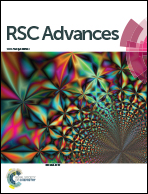Time-dependent density functional theory study on excited-state spectral and dynamic properties of hydrogen-bonded complexes formed by DMACA and water
Abstract
In this work, the excited-state spectral and dynamic properties of the two intermolecular hydrogen-bonded complexes formed by 4-(dimethylamino)cinnamic acid (abbreviated as DMACA) with water molecules have been studied using the time-dependent density functional theory (TDDFT) method. For the hydrogen-bonded complex formed at the carboxy group of DMACA, no obvious influence was found on the photochemical and photophysical processes of DMACA. However, for the hydrogen-bonded complex formed at the nitrogen atom of DMACA, the situation is quite different. The intermolecular hydrogen bond at the nitrogen atom is significantly weakened in the S1 state, which obviously enhances the S0–S1 excitation energy and explains the much larger blueshift of the absorption spectrum peak of DMACA in protonic solvents such as water. Additionally, the intermolecular hydrogen bond at the nitrogen atom directly affects the hybrid form of the nitrogen atom, which results in the obvious changes of the DMACA structure in both ground and excited states. Moreover, based on the comparisons of the S0–Sn and S0–Tn excitation energies, a new radiationless deactivation path, S1 → T2 → T1, is proposed for DMACA in protonic solvents, which sheds light on the obvious decrease of the fluorescence quantum yield of DMACA in water.


 Please wait while we load your content...
Please wait while we load your content...